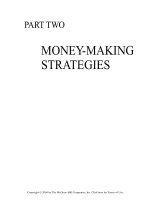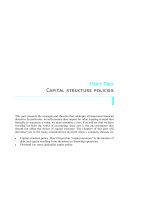2 mastering candlestick charts part 2 greg capra
Bạn đang xem bản rút gọn của tài liệu. Xem và tải ngay bản đầy đủ của tài liệu tại đây (263.79 KB, 57 trang )
Mastering
Candlestick
Charts 2
1
Disclaimer
It should not be assumed that the methods, techniques, or indicators presented in this book and seminar will be
profitable or that they will not result in losses. Past results are not necessarily indicative of future results. Examples in
this book and seminar are for educational purposes only. This is not a solicitation of any order to buy or sell.
“HYPOTHETICAL OR SIMULATED PERFORMANCE RESULTS HAVE CERTAIN INHERENT LIMITATIONS.
UNLIKE AN ACTUAL PERFORMANCE RECORD, SIMULATED RESULTS DO NOT REPRESENT ACTUAL
TRADING. ALSO, SINCE THE TRADES IN THIS BOOK and SEMINAR HAVE NOT ACTUALLY BEEN
EXECUTED, THE RESULTS WE STATE MAY HAVE UNDER OR OVER COMPENSATED FOR THE IMPACT,
IF ANY, OF CERTAIN MARKET FACTORS, SUCH AS LACK OF LIQUIDITY. SIMULATED TRADING
PROGRAMS IN GENERAL ARE ALSO SUBJECT TO THE FACT THAT THEY ARE DESIGNED WITH THE
BENEFIT OF HINDSIGHT. NO REPRESENTATION IS BEING MADE THAT ANY ACCOUNT WILL OR IS
LIKELY TO ACHIEVE PROFITS OR LOSSES SIMILAR TO THOSE SHOWN.”
The authors and publisher assume no responsibilities for actions taken by readers. The authors and publisher are not
providing investment advice. The authors and publisher do not make any claims, promises, or guarantees that any
suggestions, systems, trading strategies, or information will result in a profit, loss, or any other desired result. All
readers and seminar attendees assume all risk, including but not limited to the risk of trading losses.
Day Trading can result in large losses and may not be an activity suitable for everyone.
Copyright © 1994-2007 by Pristine Capital Holdings, Inc. All rights reserved. Printed in the United States of America.
Except as permitted under the United States Copyright Act of 1976, no part of this publication may be reproduced or
distributed in any form or by any means, or stored in a database or retrieval system, without prior written permission of
the publisher.
2
Table of Contents
Introduction
Candlestick Hype
Candle Benefits
Thoughts and Candle Language
Candle Basics
Individual Candles
Two-Bar Patterns
Three-Bar Patterns
Beyond the Basics
Pristine Candle Terms and
Understanding
Support & Resistance
Understanding Support and Resistance
A Deeper Understanding of Candles
Bar-by-Bar Analysis
Monitoring in Candle Language
Multiple Time Frames,
Volume and Indicators
General Understanding and Use
Candles in Action
Reading Greed and Fear in Candles
Combining the Candle Messages
Reversal Candle Potency
3
Candlestick Analysis
Cutting Through the Candlestick Hype
The signals on a bar chart are the same as a candle
chart.
Those signals will be seen at the same time and are
no more reliable than those of a bar chart.
The use of indicators will not increase the reliability
of candles.
There are no advanced candlestick patterns, but there is a deeper
understanding of price movements and that is the focus of The
Pristine Method®.
So, why use candle charts at all?
4
Why Use Candlesticks?
They provide a visual picture of what is occurring.
They give visual insights into others’ thoughts and expectations.
They give visual confirmation signals of support and resistance.
They can visually align your thoughts with the market.
They can visually point to potential reversal points.
5
Candlestick Analysis
Candle Language Produces Thoughts
Proper trading is said to be proper thinking, but how do we know
what to think?
Pattern recognition is a recurring arrangement of price bars that
suggests the future movement of prices, which guides our thoughts.
These patterns communicate how traders have acted and what their
beliefs (expectations) are in that time frame, at the moment.
Candles provide a picture of those expectations on an ongoing basis.
Those pictures speak to us in “Candle Language” and are the basis
6
for our continuous thoughts and trading decisions.
Candlestick Analysis
Miscellaneous Thoughts on Candlesticks
Attempting to define the accuracy of candle names or patterns
without considering the overall pattern is useless and misleading.
There are a least 50 different candle patterns, bullish and bearish.
Some memorize them, but you will see this is completely unnecessary.
While candles are very good at visually showing reversal signals,
the signals that do not work are often the most powerful!
All that is needed is a chart of price bars -- all else is secondary.
While other analysis tools may add additional information, they can
only follow existing price action.
7
Candlestick
Basics & Beyond
Review
8
Candlestick Analysis
Candle Bars
Tail
Wick
Close
Open
Body
High
Open
Body
Low
Shadow,
Wick or Tail
Shadow,
Wick or Tail
Close
The candle body is the difference between the open and the closing prices.
The part on either side of the body is called a Shadow, Wick or Tail.
9
Candlestick Analysis
Let’s first review some individual candles and their names to
make sure you have the background. See Intro to candles.
Remembering their names is unnecessary because that will
not help you use candles or understand their meaning!
When we are done, not only will you understand what candles
are saying, you will also:
Have a objective method of knowing when to enter
Know where to place a stop
Know how to monitor a position once in it
10
Candlestick Analysis
Sell Setup
3 or more bars up
in downtrend.
Bearish Doji Star
Gapped up, and opened and
closed at the same price.
Bearish Shooting Star
Narrow range body with
topping tail, near higher
end of prior bar.
Bearish Harami
Opened near the prior
bar’s close, rose and fell
during the day, closing
with small real body.
Bearish Star
Gapped up, closing under open,
leaving a small real body.
Bearish Thrust
Gapped up and
closed down less than
half way into the
prior bar’s range.
Bearish Hangman
Narrow range body with topping
tail, near higher end of prior bar.
Bearish Piercing
Gapped up and
closed down over ½
into the prior bar’s
range.
Bearish Engulfing
Gapped up and fell
down to engulf the
entire prior bar’s real
body.
Prices are trending higher, the potency of the reversal signals are increasing. 11
Candlestick Analysis
Buy Setup
3 or more bars
down in uptrend.
Bullish Doji Star
Gapped down, and opened
and closed at the same price.
Bullish Hammer
Bullish Harami
Narrow range body with
Opened near the prior
bottom tail, near lower end bar’s close, fell and rose
of prior bar.
during the day, closing
with small real body.
Bullish Star
Gapped down, closing over open,
leaving a small real body.
Bullish Thrust
Gapped down and
closed up less than
half way into the
prior bar’s range.
Bullish Inverted Hammer
Narrow range body with topping
tail, near lower end of prior bar.
Bullish Piercing
Gapped down and
closed over ½ into
the prior bar’s range.
Bullish Engulfing
Gapped down and rose
up to engulf the entire
prior bar’s real body.
Prices are trending lower, the potency of the reversal signals are increasing.
12
Candlestick Analysis
The level of accumulation and
distribution will be seen through
candles displaying shifts
in momentum.
Those shifts take on various forms.
Your job is to recognize them and
assess the odds of follow through.
13
Candlestick Analysis
Narrow
Range
Wide
Range
Range
Expansion
Range
Expansion
A Narrow Range bar can indicate that momentum has slowed or that volatility is low.
A WRB or RE bar displays commitment and emotion.
A Wide Range Bar (WRB) is a Range Expansion (RE) by definition.
A Bottom Tail (BT) or Top Tail (TT) may or may not be a Range Expansion (RE) bar.
A WRB is an indication that momentum may soon slow or end an existing move.
A WRB Breakout or Breakdown, after a consolidation, ignites a move in that direction.
14
Candlestick Analysis
Shooting Star
Separating
lines
Harami
Bearish
At times, candle patterns have
No Follow Through (NFT) to
their suggested meaning.
DOJI
Engulfing
Bullish,
but GBI
Hammer
RBI
Engulfing
Bearish
High Wave
RBI?
Red bars ignored (RBI) and
Green bars ignored (GBI) can
provide powerful messages!
Engulfing
Bullish
1515
Candlestick Analysis
A signal bar, two-bar or three-bar candle pattern can point
you to high probability reversal points, but ….
By interpreting the meaning of all recent candles combined,
the odds of successfully locating a reversal increase.
We will now consider the trend of current bars, support,
resistance, volume, and a monitoring technique.
16
Support and
Resistance
Basics
17
Candlestick Analysis
Candlestick analysis is a powerful tool that
becomes more powerful with the additional
understanding of Support and Resistance.
This introduction to Pristine’s systematic
approach to analyzing Support and
Resistance will give you a real advantage!
Let’s take a look!
18
Candlestick Analysis
What is Support and Resistance?
The only “real” support or
resistance is price.
Prior highs and lows
Overlapping price bars (e.g., a base)
An unfilled gap between price bars
Subjective Support and Resistance
Trading Bands or Envelopes
Fibonacci Retracements
Moving Averages
Trendlines
These tools are subjective and unnecessary
when you understand what is real.
Pristine Capital Holdings, Inc.
19
Candlestick Analysis
Basic Support – Resistance
The first reference of support is a prior candle’s low, so a bearish
candle’s low must be violated to confirm a bearish signal.
If that bearish candle’s high is overcome on a closing basis first,
the signal has been negated.
The number of bars making up prior support or resistance will
suggest the odds of overcoming or not overcoming that area.
Prior highs, lows, and gaps are focal points of potential reversals.
20
Candlestick Analysis
The Open = Beginning S / D
The Low = Demand, Support
The Close = Ending S / D
The High = Supply,
Resistance
The Body = The difference between the open and close, which is the
degree by which the battle between Bulls and Bears has been won or lost
High =
Supply
Close
High =
Supply
60%
40%
50%
50%
Body
Body
40%
60%
Open
Low =
Demand
Open
Close
Low =
Demand
The closing price within the range of a candle is a measurement
Pristine Capital Holdings, Inc.
of the strength of the bulls or bears in that period.
21
Support and Resistance Analysis
The first point of support is the prior bar’s low.
The first point of resistance is the prior bar’s high.
The second point of support or resistance is a Pivot Point.
New First Resistance
First Resistance
Pivot High
LH
LH
HL
Pivot Low
HL
First Support
HL
HL
Pristine Capital Holdings, Inc.
22
Support and Resistance Analysis
Multiple bars or congestion is a significant area of Resistance or Support.
They form rounding or square formations within a trend.
One-to-three bars reversals are less significant.
Congestion = Resistance
No
Resistance
No
Congestion
No
Congestion
No
Support
Retest
Pristine Capital
Holdings, Inc.
Congestion!
This is not support
until there is a close
decisively above it.
23
Candlestick Analysis
Gaps are considered support or resistance
reversal points, but it is not that simple.
Prices pull back into the gap with
several bars and form a potent + COG.
This pattern suggests a reversal.
GAP
Potent + COG
GAP
Prices exploded into the gap
with a + WRB suggesting
continuation, not a reversal.
24
Candlestick Analysis
Three or more bars moving into a Gap, followed by
slowing momentum, sets up up a high-odds trade
Read the candles as they form
Expanding
GAP
One or two bars
moving into a Gap on
expanding momentum
suggests continuation.
GAP
Slowing
25









